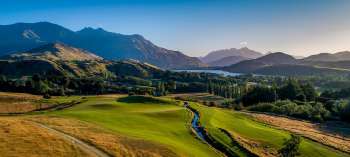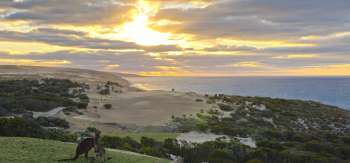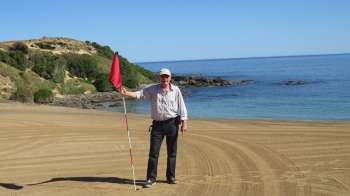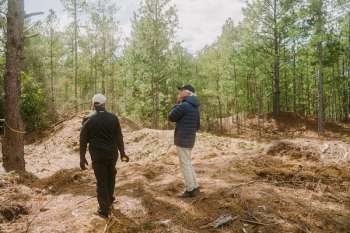Designed by Darius Oliver, The Farm officially opens for play.
Amidst celebrations last week for the 100th staging of the New Zealand Open, was the official opening of a unique par three course at The Hills Golf Club near Queenstown.
Designed by Darius Oliver and known as “The Farm”, the course was christened with the playing of a 140-person “Champions Day” 9-hole tournament. Club founder Sir Michael Hill, who described The Farm as “possibly my finest achievement”, was among the participants alongside 120 keen amateurs and more than a dozen former winners of the NZ Open.
Beyond its reputation as a regular tournament venue, The Hills is renowned globally for an incredible collection of outdoor sculptures. From the giant “Seated Man” statue left of the 1st hole through to the 100-strong pack of attacking wolves beside the 18th fairway, the artwork dotted across the course can distract even those playing their poorest golf.
Adding to the appeal of this exceptional member-only facility is The Farm, an elastic ‘choose your own adventure’ style par three course blessed with stunning scenery, fun holes and nine gloriously diverse green settings that can be approached by all and with any club in the bag. Built with the lightest of touches and devoid of bunkers, The Farm features wall-to-wall browntop bent, a magnificent near century-old irrigation race and was designed to be maintained by fewer than two full time staff members.
As far from a simple ‘pitch and putt’ layout as you might find, the concept here was for The Farm to be both fun for absolute beginners, as well as a thrilling, stiff challenge (if necessary) for the accomplished golfer. Essentially, the member can choose to make their round as easy or as difficult as they wish. They can play at a range of distances and from a great variety of angles, and with as many, or as few clubs, as they like. The Hills General Manager Brendan Allen played the Champions Day tournament with just a 6-iron and putter, and finished one shot behind the top Amateur.
The Champions Day event reflected the philosophy and playability of the concept. 82-year old Kiwi legend Sir Bob Charles thrilled spectators with a hole-in-one on the final green, while 10-year old Josh Harris shot a one-over par 28 in the morning drizzle to finish one stroke behind the leading Amateur and only two behind the best of the Professionals. Young Harris tied former Australian Cricket Captain, and scratch marker, Ricky Ponting.
Course designer Darius Oliver was particularly pleased with the opening event, despite it being played in difficult conditions, and spoke glowingly of The Hills and how the holes had matured over the New Zealand summer.
“Words really fail here” said Oliver, “to do justice to this project and to the thrill of being involved in the creation of The Farm. Imagine being a golf course designer and wanting to build a beautiful, elastic par three course that was playable and fun for beginners yet also challenging and fun for really good golfers – and then being offered this sort of site.
As soon as we finished the routing we knew the potential was enormous, and although I’m proud of all nine holes and the overall finished product, I’m realistic about how much credit I can take for how it turned out. The site really is the star attraction. Not only is the scenery incredible and the almost 100 year-old water race perfectly positioned for thrills and excitement, no two holes are even remotely alike, nor do any of the greens require the same sort of approach. None of the views ever get old or tired, nor do the holes. I could play them all day.
On top of a great site, we enjoyed the benefits of both an uncompromised approach to development from the ownership as well as the complete commitment of a talented in-house construction and grow-in team. Club Superintendent/General Manager Brendan Allen did an amazing job managing construction, and then the growing-in of seeded browntop bentgrass greens and tees to blend seamlessly with native areas that we mowed down. He and his staff were brilliant to work with, as was our lead shaper Tom Paterson.
Enjoying a round on The Farm last week with Brendan, Sam, Ben, Tom, and later with Sir Michael, was a real joy, though the highlight for me was seeing Lady Christine Hill playing golf again after many years away from the game. Her and Sir Michael carry a small bag with a handful of clubs and play with their dogs in tow. It warms the heart, and proves to me that we built something at The Hills that can endure.
There isn’t a golf club anywhere in the world like The Hills – and there isn’t a short course like The Farm. I can’t think of any better, or another that I could happily play for the rest of my life. Members will quickly learn the joy of mixing tee angles, and attempting both aerial and bouncing approach shots. Even those with professional aspirations will struggle to get bored playing here. I love the place, and as soon as I boarded the plane back to Melbourne last week was immediately dreaming of a return."
Above – Aerial photo by AirSwing Media showing the 4th (bottom), 5th (left) and cross-over 6th (right) holes.
Hole by Hole descriptions:
1st Hole – 20m to 200m

Above – Golfers can choose to play the 1st from atop the water race or anywhere alongside its bank.
Aside from the stunning Otago scenery, the main feature of The Farm is the almost 100-year old Arrow Irrigation Race, which runs through the property. The 1st tee is set directly on top of the race, golfers playing along the water hazard or out to the left side and into a double green shared by the 1st and 8th holes. An elevated back tee can stretch shots to around 200 metres, while shorter hitters and beginners can tee from anywhere alongside the water race.
2nd Hole – 80m to 175m
Above – View from the upper tee on the 2nd hole.
The big reveal after walking along the top of the water race to the second tee is almost as thrilling as the downhill tee shot itself, where balls seem to hover against the horizon of The Remarkables (Mountain Range). From back tees you need to carry a large ravine in order to reach the headland green. The beauty of this hole, however, is the flexibility of the teeing grounds; golfers can choose an all-carry angle from the right or move further left along the race wall and essentially bounce their ball onto the green. Kids and shorter hitters can even punch or putt shots off a ridge that flows all the way into the putting surface.
Above – Aerial photo by AirSwing Media from behind the 2nd green, showing how forgiving the left side is.
3rd Hole – 70m to 165m
Above – The 3rd hole features a semi blind tee shot but this deceptively generous green site.
Blind or slightly blind depending on the pin and your chosen tee, the 3rd rises over a gentle hillock to a subtle green set in a shallow valley. The green site is far more forgiving than it appears from the tee, and can be approached by forward tee golfers from an elevated pad around 70m from the green.
4th Hole – 70m to 200m
Above – view from behind the 4th green.
As natural a par three as you could find, the fairway on the valley 4th comprises of mowed down native bents which provide for endless teeing options. The green here is nestled between two small hills, and angled from back right to front left. A shift of pin makes a big difference to how to best play the tee shot, as does a simple switch from one side of the teeing ground to the other.
5th Hole – 75m to 120m
Above – Photo by AirSwing Media from above the 5th green.
Turning back to the west, the skyline 5th has arguably both the most dangerous green and the most distracting backdrop. Long looks dead when the pin is left, but short-siding yourself on the right leaves perhaps the toughest two putt on the course. This gorgeous little hole is subject to the cross winds and demands a precise pitch or punch shot from those hoping to make birdie.
6th Hole – 70m to 140m
Above - Sideview of the halfpipe green site at the 6th hole.
Crossing the 4th fairway and playing slightly uphill, the 6th was labelled by Sir Bob Charles as the “Lahinch” or “Dell” hole owing to its hidden sunken green. The landforms provide all the information you need from the tee here, play it slightly long and slightly left and you should nestle quite close to the hole. Recovery shots can generally be played left, right or long off the steepest bank.
7th Hole – 20m to 120m
Above – View from tee through green on the short 7th hole.
From atop the water race and played across the hazard into a gorgeous natural green setting, the 7th can be anything from a punch short iron to a chip. Short and back left pins here are treacherous, but central pins are very accessible as a right bank feeds balls into the middle of the green.
Above – AirSwing Media photo from above the 7th green.
8th Hole – 20m to 180m
Above – The 8th plays into the double green from either above the water race wall, or directly on top of it.
From the near side of the water race, tee shots here generally carry the hazard twice before reaching the double green. Given the difficulty of horizontal hazards for beginner golfers, teeing grounds were built along the entire race wall meaning the hole can be a stiff challenge for good players from the back, but a chip and putt for those off the front.
9th Hole – 70m to 180m
Above – View across the 9th green from near the 1st tees.
The only manufactured green site on the course, the 9th was able to blend with its natural surroundings thanks to a substantial amphitheatre setting and the excellent work of shaper Tom Paterson and club Superintendent Brendan Allen in first creating the landforms necessary to make the steeply pitched green work, and then raising the level of the greenside pond to provide additional excitement. A soft fade is your only chance at birdie if you choose to play directly at the pin, most golfers prefering instead to feed their ball from the right half of the green or even off the hillside near the 1st tee.
More News
The Cliffs Kangaroo Island Announces Preview Play in early 2026
Major milestone for stunning new destination course with preview play available from January 2026
Who Really Designed Cape Wickham Links?
AGD ranks Cape Wickham #1 in Australia & interviews Duncan Andrews to get full story on course design
Cape Wickham Links – The Inside Design Story
Co-designer Darius Oliver reveals the truth behind the design of Australia’s premier modern golf course
Coore & Crenshaw to design new No. 11 Course at Pinehurst Resort
Pinehurst announces that famed design team will design its 11th course on the former Sandmines site





